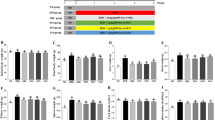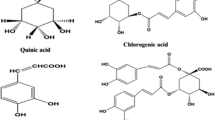Abstract
The effect of dietary hesperetin on the hepatic lipid content and the enzyme activities involved in triacylglycerol (TG) synthesis in rats fed diets with or without 1% orotic acid (OA) was studied. Hepatic TG content was raised by approximately 5-fold after administration of OA for 10 days. The OA-feeding significantly increased the activity of hepatic microsomal phosphatidate phosphohydrolase (PAP), which is the rate-limiting enzyme for TG synthesis. Hepatic glucose-6-phosphate dehydrogenase (G6PDH) and malic enzyme activities were also increased. An addition of 1% hesperetin to the OA-supplemented diet resulted in the decrease of the hepatic TG content by 44% and of microsomal PAP activity. Dietary hesperetin alone neither affected liver TG content nor PAP activity significantly. OA-feeding caused an increased liver cholesterol level, whereas simultaneous addition of hesperetin and OA reduced its content to the control level. A slight reduction of hepatic cholesterol by hesperetin was also observed in the OA-free dietary group. The present study demonstrated that dietary hesperetin can reduce the hepatic TG accumulation induced by OA, and this was associated with the reduced activity of TG synthetic enzyme, PAP.
Similar content being viewed by others
References
Mouly PPM, Arzouyan CG, Gaydou EM, Estienne JM (1994) Differentiation of citrus juices by factorial discriminate analysis using liquid chromatography of flavanone glycosides. J Agric Food Chem 42: 70-79.
Rouseff RL, Martin SF, Youtsey CO (1987) Quantitative survey of narirutin, naringin,hesperidin and neohesperidin in citrus. J Agric Food Chem 35: 1027-1030.
Middeton E, Kanadaswami C (1992) Effects of flavonoids on immune andinflammatorycell functions. Biochem Pharmacol 43: 1167-1179.
Kimura Y, Kubo M, Tani T, Arichi S, Okuda H (1981) Studies on scutellariae radix. IV, Effects on lipid peroxidation in rat liver. Chem Pharm Bull 29: 2610-2617.
Hisatomi T, Hara E, Furukawa J, Cha J-Y, Anno N, Yanagita T (1995) Effect of dietary hesperidin and their aglycone on the lipid metabolism in rats. In: Annual Regional Meeting of Agricultural Chemical Society of Japan, Oct 1995, Japan Hiroshima, Abstract p 121.
Monforte MT, Trovato A, Kirjavainen S, Forestieri AM, Galati EM (1995) Biological effects of hesperidin, a citrus flavonoid. (note II): Hypolipidemic activity on experimental hypercholesterolemia in rat. Farmco 50: 595-599.
Hamilton RL, Guo LSS, Felker TE, Chao Y, Havel RJ (1986) Nascent high density lipoprotein from liver perfusates of orotic acid fed rats. J Lipid Res 27: 967-978.
Hay R, William RF, O'Connell W, Kirschner J, Oppliger W (1988) Apolipoproteins of the orotic acid fatty liver: implications for the biogenesis of plasma lipoproteins. J Lipid Res 29: 981-995. 357
Cha J-Y, Mameda Y, Oogami K, Yamamoto K, Yanagita T (1998) Association between hepatic triacylglycerol accumulation induced by administering orotic acid and enhanced phosphatidate phosphohydrolase activity in rats. Biosci Biotechnol Biochem 62: 508-513.
Yanagita T, Oogami K, Yamamoto T, Cha J-Y, Nunez J (1995) Triglyceride metabolism of fatty liver and the prevention by dietary n-3 fatty acid. Proc Jpn Conf Biochem Lipids 38: 3-6.
Miyazawa S, Furuta S, Hashimoto T (1982) Reduction of β-oxidation capacity of rat liver mitochondria by feeding orotic acid. Biochim Biophys Acta 711: 494-502.
Aoyama Y, Yohida A, Ashida K (1981) Effect of some dietary additions to either an arginine-devoid diet or a diet supplemented with orotic acid refed after starvation on liver lipid content during essential fatty acid deficiency in rats. J Nutr 111: 895-906.
Miyasaka H, Sanada H, Ayano Y (1992) Relationship between colonic products from corn bran hemicellulose and the lipid metabolism in rats fed on diets supplemented with orotic acid. Biosci Biotechnol Biochem 56: 157-158.
Sugiyama K, Ee P, Wada S, Tamaki F, Saeki S (1998) Green tea suppresses Dgalactosamine-induced liver injury in rats. Biosci Biotechnol Biochem 62: 609-911.
American Institute of Nutrition (1993) (AIN)-93 purified diets for laboratory rodents: Final report of the American Institute of Nutrition Ad Hoc Writing Committee on the reformulation of the AIN-76 roden diet. J Nutr 123: 1939-1951.
Folch J, Lees M, Sloane-Starley GH (1957) A simple method for the isolation and purification of total lipids from animal tissues. J Biol Chem 226: 497-509.
Fletcher MJ (1968) A colorimetric method for estimating serum triglyceride. Clin Chim Acta 22: 393-397.
Sperry WM, Webb M (1950) Averision of the Shoenheimer-Sperry method for cholesterol determination. J Biol Chem 187: 97-106.
Yanagita T, Satoh M, Enomoto N, Sugano M (1978) Di(2-ethylhexyl)phtalate enhances hepatic phospholipid synthesis in rats. Biochim Biophys Acta 919: 64-70.
Zakim D, Donald VA (1973) Techniques for the characterization of UPDglucuronyltransferase, glucose-6-phosphate, and other tightly bound microsomal enzymes. Meth Biochem Anal 21: 1-37.
Lowry OH, Rosenbrough NJ, Farr AL, Ranll RJ (1951) Protein measurement with the folin phenol reagent. J Biol Chem 193: 265-275.
Walton PA, Possmayer F (1984) The role of Mg2+-dependent phosphatidate phosphohydrolase in pulmonary glycerolipid biosynthesis. Biochim Biophys Acta 796: 346-372.
Glock G, McLean P (1953) Further studies on the properties and assay of glucose-6-phosphate dehydrogenase and 6-phosphogluconate dehydrogenase of rat liver. Biochem J 55: 400-408.
Ochoa S (1955) Malic enzyme. Meth Enzymol 1: 739-741.
Coleman RA, Bell RM (1976) Triacylglycerol synthesis in isolated fat cells. J Biol Chem 251: 4537-4543.
Duncan DB (1957) Mutiple range test for correlated and heteroscedastic means. Biometrics 13: 164-176.
Tokmakjian SD, Haines DSM (1985) Early effects of dietary orotic acid upon liver lipid synthesis and bile cholesterol secretion in rats. J Lipid Res 26: 478-486.
Hopewell R, Martin-Sanz P, Martin A, Saxton J, Brindley DN (1985) Regulation of the translocation of phosphatidate phosphohydrolase between the cytosol and the the endoplasmic reticulum of rat liver. Biochem J 232: 485-491. 358
Fremont L, Gozzelino MT (1996) Dietary sunflower oil reduces plasma and liver triacylglycerols in fasting rats and is associated with decreased liver microsomal phosphatidate phosphohydrolase activity. Lipids 3: 871-878.
Halminski MA, Marsh JB, Harrison EH (1991) Differential effects of fish oil, safflower oil and palm oil on fatty acid oxidation and glycerolipid synthesis in rat liver. J Nutr 121: 1554-1561.
Ikeda I, Cha J-Y, Yanagita T, Nakatani N, Oogami K, Imaizumi K, Yazawa K (1998) Effects of dietary á-linolenic, eicosapentaenoic and docosahexaenoic acids on hepatic lipogenesis and β-oxidation in rats. Biosci Biotechnol Biochem 62: 675-680.
Igarashi K, Ohmuma M (1995) Effects of isorhamnetin, rhamnetin and quercetin on the concentration of cholesterol and lipoperoxide in the serum and liver on the blood and liver antioxidative enzyme activities of rats. Biosci Biotechnol Biochem 59: 595-601.
Yanagita T, Cha J-Y, Furukawa J, Hara E, Hisatomi T (1996) The inhibitive actions of hesperetin and naringenin on the activity of acyl CoA-cholesterol acyltransferase in rats. In: Annual Meeting of Agricultural Chemical Society of Japan, Mar./Apr. 1996, Japan Kyoto, Abstract p 35.
Yotsumoto H, Yanagita T, Yamamoto K, Ogawa Y, Cha J-Y, Mori Y (1997)Inhibitory effects of Oren-Gedoku-to and its components on cholesteryl ester synthesis in cultured human hepatocyte HepG2 cells: Evidence from the cultured Hep G2 cells and in vitro assay of ACAT. Planta Med 63: 141-145.
Author information
Authors and Affiliations
Rights and permissions
About this article
Cite this article
Cha, JY., Cho, YS., Kim, I. et al. Effect of hesperetin, a citrus flavonoid, on the liver triacylglycerol content and phosphatidate phosphohydrolase activity in orotic acid-fed rats. Plant Foods Hum Nutr 56, 349–358 (2001). https://doi.org/10.1023/A:1011884200848
Issue Date:
DOI: https://doi.org/10.1023/A:1011884200848




